To keep your van's rear AC vents running smoothly and guarantee a comfy ride, regular maintenance is key. Start by checking and cleaning air filters every 1-3 months to maximize airflow. Don't forget to inspect ducts and vents for blockages caused by cargo or dirt. Using 12V mini fans can provide extra cooling when needed. Park in shaded spots or use sunshades to minimize heat buildup inside. Keep a log of your maintenance tasks to stay organized and save on costs. There's a lot more to discover about maintaining your rear ventilation system effectively.
Importance of Rear AC Vents
Rear AC vents play an important role in enhancing overall passenger comfort in your vehicle. These vents provide additional cooling or heating, which is especially vital during hot summer drives. Without proper airflow, those seated in the back can experience discomfort, making their ride less enjoyable.
The effectiveness of rear AC vents can vary based on vehicle design, ductwork, and HVAC settings. Sometimes, airflow from these vents mightn't match the strength of front vents, especially when temperatures soar over 100 degrees Fahrenheit. You might notice weaker airflow towards the rear, which can lessen the comfort level for your passengers. Additionally, utilizing expense management apps can help you track costs effectively while maintaining your vehicle.
Regular maintenance of rear AC vents is essential to guarantee optimal airflow and cooling efficiency. Cleaning and checking for obstructions can greatly improve performance, directly impacting your overall ride comfort. Additionally, utilizing tools for expense tracking can help you manage the costs associated with vehicle maintenance effectively. Moreover, understanding the significance of financial reporting can assist in budgeting for necessary repairs and upkeep.
Additionally, some vehicles lack dedicated rear AC units, which can limit effectiveness. Being aware of your vehicle's design helps you manage expectations regarding rear ventilation.
Ultimately, understanding the importance of rear AC vents can greatly enhance the comfort of your passengers, making every journey more pleasant.
Common Rear AC Vent Issues
Maintaining ideal airflow from your vehicle's AC vents can be challenging when issues arise. One of the most common problems with rear vents is blockage caused by cargo or seat adjustments. When these vents are obstructed, airflow and cooling efficiency can take a significant hit, leaving your passengers uncomfortable. Regularly monitoring savings and investments is essential for maintaining your vehicle's comfort levels, just as it is for financial health. Additionally, timely payments for vehicle maintenance can prevent larger issues that may disrupt airflow.
Electrical issues can also disrupt the operation of rear AC vents. You should regularly inspect fuses and connections to verify everything's functioning properly. If you notice weak airflow, especially in larger passenger areas or during extreme temperatures, it's worth investigating further.
Another common concern is clogged filters or dirty vents, which can reduce airflow and overall performance. Regular maintenance is essential to avoid these issues.
Additionally, check your HVAC settings, as automatic climate control may unintentionally divert airflow away from the rear vents, affecting comfort for those seated in the back. Implementing clear communication regarding maintenance schedules can further enhance the overall performance of your vehicle's AC system.
Regular Maintenance Practices
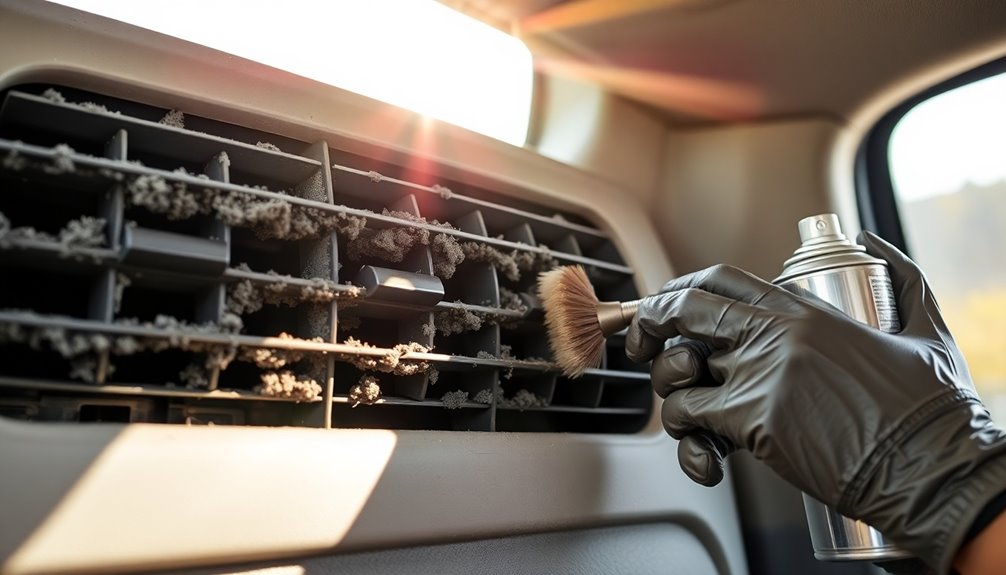
To keep your van's rear AC vents working efficiently, you should check your air filters regularly and clean them every 1-3 months. It's also crucial to inspect and clean the ducts and vents to prevent blockages that can limit airflow. Additionally, maintaining your vehicle's comfort systems can be simplified by using expense tracking apps that help you manage related maintenance costs effectively. By incorporating automated savings into your financial routine, you can better allocate funds for necessary vehicle maintenance. Regular monitoring of your expenses through these apps can provide insights into your spending habits, helping you make informed decisions about maintenance budgets.
Check Air Filters Regularly
Every few months, checking and replacing your van's air filters is essential for guaranteeing peak airflow in the rear AC system.
Regular maintenance of air filters keeps the airflow smooth and prevents the buildup of dust and allergens, which can negatively affect air quality. Clogged filters can restrict airflow, leading to decreased cooling efficiency and increased strain on the HVAC system. This can result in higher energy costs and potential system failures.
To maintain peak performance, replace your air filters every 1-3 months. Choose high-quality filters that meet your van's specifications for maximum effectiveness—these can trap more particles, improving air quality.
If you're looking to save money, consider using washable and reusable filters. Just remember to clean them regularly to guarantee consistent airflow.
Keeping a maintenance log for filter changes can help you track when it's time to replace them, guaranteeing uninterrupted airflow for a comfortable ride.
Clean Ducts and Vents
Keeping your van's air ducts and vents clean is essential for ideal airflow and air quality. Regularly checking and cleaning these areas prevents dust, debris, and allergens from accumulating, which can hinder performance. Aim to clean ducts and vents at least once or twice a year to maintain system efficiency.
Start by using a vacuum and a cleaning brush to remove dirt from the vent covers and ducts. This simple step can make a significant difference in airflow.
Don't forget to inspect and replace air filters as needed; clogged filters can really reduce airflow and strain your HVAC system.
If you're looking for a deeper clean, consider hiring a professional HVAC service. They use specialized equipment to guarantee complete debris removal, achieving a level of cleanliness that's tough to match with DIY methods.
Engaging in routine maintenance practices, like guaranteeing proper fan settings, can also enhance your rear AC unit's performance, making every ride more comfortable.
Inspect for Blockages
Inspecting for blockages in your rear AC vents is essential for maintaining airflow and cooling efficiency. Regular checks can prevent obstructions that considerably reduce performance. Here are three key areas to focus on:
- Cargo Placement: Confirm that your luggage or items aren't blocking air vents.
- Seat Adjustments: When adjusting seats, be mindful of how it may impact airflow to the rear air vents.
- Debris Accumulation: Clean around the vents regularly to remove dust and grime.
By taking the time to inspect for blockages, you'll enhance the effectiveness of your air conditioning system.
It's also important to check for leaks in the ductwork, as these can lead to reduced cooling capacity. If you notice weak airflow, address it promptly to avoid further complications and confirm passenger comfort.
Additionally, schedule routine maintenance that includes inspecting and cleaning the rear return vent. This practice helps keep your air vents clear and maintains effective airflow throughout your vehicle.
Your passengers will appreciate the consistent, cool environment, and you'll enjoy a more comfortable ride.
Cleaning Air Vents Effectively
To effectively clean air vents, start by turning off the power to your HVAC system; this guarantees safety and prevents any accidental operation while you work.
Once you've done that, grab a screwdriver to remove the air duct covers, giving you better access to the vents for thorough cleaning. Additionally, consider using AI-driven tools to help manage your cleaning supplies efficiently, as they can assist in tracking your cleaning inventory and remind you when to restock.
Next, use a cleaning brush to eliminate dust and grime. For those stubborn dirt patches, a mixture of soap and water can work wonders to restore cleanliness.
After you've brushed away the debris, vacuum the air vent thoroughly to remove any dislodged dirt. If you want to take it a step further, consider renting a heavy-duty vacuum for a deeper clean.
Once you're satisfied with your work, reattach the covers to the ducts.
Finally, restore power to your HVAC unit to guarantee proper airflow resumes. Additionally, regularly reviewing your billing process can help ensure your maintenance expenses are managed efficiently, allowing for a better understanding of your financial health.
Cleaning Air Ducts Tips
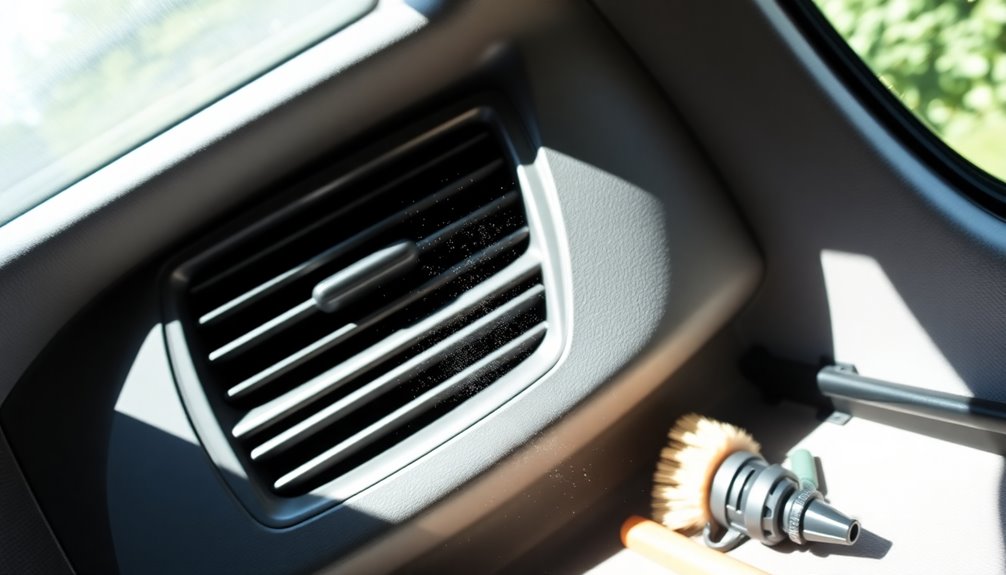
Regularly cleaning your air ducts can greatly improve your van's air quality and HVAC efficiency. Neglecting this maintenance can lead to health issues and increased energy costs, especially for allergy sufferers. Timely reminders can also play a crucial role in maintaining a consistent cleaning schedule.
Here are three tips to help you with cleaning air ducts:
- Schedule Deep Cleanings: Aim to deep clean your air ducts once or twice a year. This frequency guarantees that allergens and debris are removed, enhancing your van's air quality. Consistent cleaning habits can contribute to better financial management as it helps avoid costly repairs in the long run. Additionally, maintaining a clean HVAC system can lead to enhanced control over your overall vehicle expenses.
- Consider Professional Help: While DIY methods are tempting, professional HVAC services use specialized vacuums that thoroughly clean ducts, capturing debris that you might miss. This can save you from potential health risks and costly repairs down the line.
- Replace Air Filters Regularly: Clogged filters can restrict airflow and contribute to dirty ducts over time. By checking and replacing your air filters regularly, you'll not only improve air quality but also prolong the lifespan of your HVAC system. Additionally, using automated reminders for timely maintenance can help ensure you stay on top of your cleaning schedule.
Understanding Air Filter Placement
Understanding air filter placement is key to keeping your van's rear AC system running smoothly.
Make certain you pay attention to the arrows on the filter to guarantee proper orientation and schedule regular maintenance checks.
A well-placed filter not only improves airflow but also helps prevent costly repairs down the line.
Proper Filter Orientation
Proper air filter orientation plays a significant role in maintaining efficient airflow within your vehicle's HVAC system. When you install your air filter correctly, you guarantee that contaminants are effectively trapped, preventing them from entering the system.
Here are a few reasons why proper filter orientation is important:
- Optimal Airflow: Correct placement allows for unrestricted airflow, enhancing overall HVAC efficiency.
- Energy Savings: When airflow is unobstructed, your system doesn't have to work as hard, saving you money on fuel and energy.
- Component Longevity: Proper filter orientation minimizes wear and tear, prolonging the lifespan of your HVAC components.
If you don't pay attention to the arrows on the filter indicating the correct installation direction, you risk reducing system efficiency. This can lead to increased energy consumption and strain on your HVAC components.
Regularly checking the air filter placement is essential. A filter installed incorrectly can cause your rear AC vents to underperform, impacting passenger comfort.
Filter Maintenance Schedule
Maintaining a consistent filter maintenance schedule is essential for guaranteeing ideal airflow in your van's HVAC system. You should check and replace air filters every 3 to 6 months to keep dust and debris from building up. This practice not only enhances air quality but also prevents potential airflow restrictions that can lead to increased energy consumption and unnecessary strain on your system.
When you're inspecting your filters, pay attention to their installation. Make sure the arrows on the filter point toward the engine, indicating proper airflow direction. This guarantees efficient filtration and peak performance.
Regularly inspecting your cabin air filters as per the vehicle manufacturer's recommendations will help maintain a comfortable environment inside your van.
Neglecting your filter maintenance schedule can lead to higher repair costs and shorten your HVAC system's lifespan. By staying on top of filter checks and replacements, you can identify issues early, saving you time and money in the long run.
Impact on Airflow
Air filter placement plays an essential role in your van's airflow efficiency. If the air filter isn't installed correctly, it can greatly hinder air flow, leading to reduced efficiency in your HVAC system and a noticeable drop in cooling performance.
Here are three key points to remember:
- Correct Direction: Always install your air filters according to the arrows on the filter. This guarantees contaminants are trapped effectively before they enter the HVAC system.
- Regular Checks: Make it a habit to regularly check your air filter placement. This simple action can prevent airflow issues and enhance the overall performance of your rear AC vents.
- Avoiding Strain: Improperly placed or clogged filters can place unnecessary strain on your AC system, leading to higher energy consumption and potentially costly repairs.
Troubleshooting Air Flow Problems
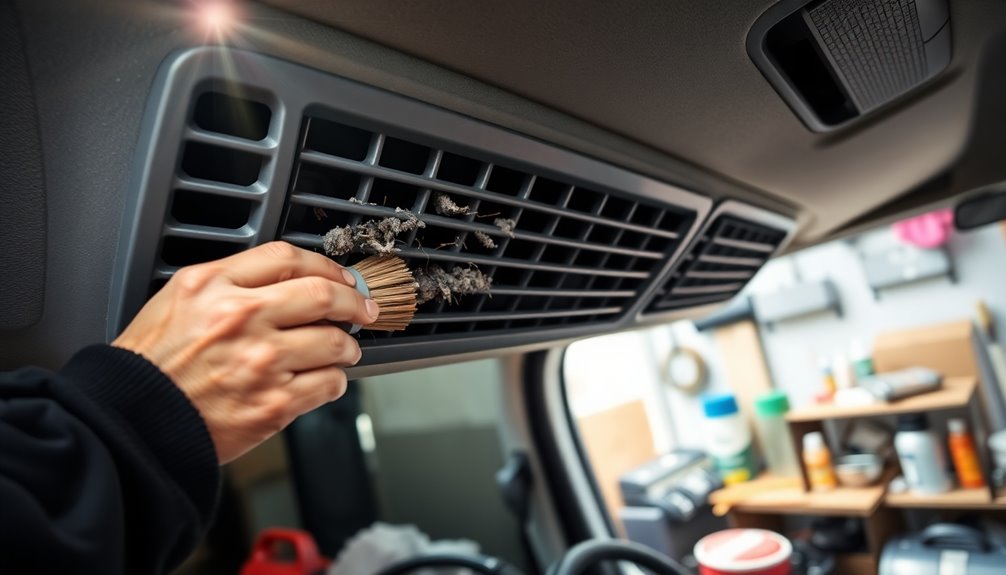
When you notice reduced airflow from your van's rear AC vents, it can turn a comfortable ride into an uncomfortable experience.
Start by checking for any blocked vents. Furniture or cargo in the rear seating area can greatly restrict airflow, so clear away obstructions to guarantee ideal air distribution.
Next, inspect the air filters; clogged filters are a common culprit behind airflow issues. Regularly check and replace them to maintain effective circulation in the rear AC unit.
Don't forget to look at the ductwork. Disconnections or leaks can lead to inadequate air delivery, diminishing cooling performance in the rear cabin.
Additionally, make sure that dampers on affected vents are open. Closed dampers can severely limit the effectiveness of your rear AC system.
If you've gone through these checks and airflow problems persist, it might be time for a professional inspection.
There could be deeper issues within the HVAC system that require expert attention. By addressing these potential problems, you'll be well on your way to restoring comfort during your journeys.
Optimizing HVAC Settings
To optimize your HVAC settings, start by adjusting the fan speed to the highest level you can tolerate for cooling.
You might also consider closing any unused front vents to redirect airflow towards the rear, enhancing comfort for your passengers.
Finally, opting for manual control lets you fine-tune the system based on real-time needs.
Adjust Fan Speed
During your journey, adjusting the fan speed can make a noticeable difference in comfort for rear passengers.
By optimizing the airflow, you guarantee everyone enjoys a pleasant ride. Here are three key tips to take into account:
- Set Fan Speed to High: Adjust the fan speed to the highest tolerable setting. This greatly enhances airflow from the rear AC vents, improving overall comfort for those sitting in the back.
- Select Face-Level Vents: Choosing face-level vents in your HVAC settings maximizes the distribution of cool air directly towards rear passengers. This targeted airflow can make a big difference on hot days.
- Manual Control: Use manual control for the fan speed instead of relying on automatic settings. Automatic features may divert air to defrost or floor vents, reducing airflow to the rear, which can lead to discomfort.
Close Unused Front Vents
Adjusting fan speed is just one way to improve rear passenger comfort, but another effective method is to close unused front vents. By doing this, you can redirect airflow to the back of the van, which increases cooling efficiency during hot weather. When you close unused front vents, you raise the airflow pressure through the rear AC vents, making your passengers feel more comfortable.
This technique is particularly beneficial when your vehicle is fully loaded with passengers or cargo. As you prioritize rear airflow, setting the front blower fan to a higher speed guarantees that more conditioned air reaches the back, optimizing the overall climate control experience.
It's a simple adjustment, but it can make a noticeable difference. Regularly adjusting your HVAC settings based on passenger needs can help maintain a comfortable temperature throughout the vehicle, especially on longer trips.
Manual Control Preference
Enhancing your HVAC settings for manual control can greatly improve the comfort of rear passengers. By taking charge of your van's climate control, you can create a more enjoyable ride for everyone. Here are three essential tips to keep in mind:
- Direct Airflow: Set the HVAC system to face-level vents to maximize airflow towards passengers in the rear seating area.
- Adjust Fan Speed: Increase the fan speed to the highest tolerable setting, especially on hot days, to boost cooling performance.
- Close Unused Front Vents: Redirect airflow by closing any front vents that aren't in use, ensuring the rear passengers stay cool and comfortable.
Choosing manual control preference over automatic settings allows you to maintain a consistent airflow and prevents air from being diverted to unintended areas.
Regularly check and adjust your HVAC settings based on passenger needs, ensuring that everyone enjoys ideal climate control.
Enhancing Air Circulation
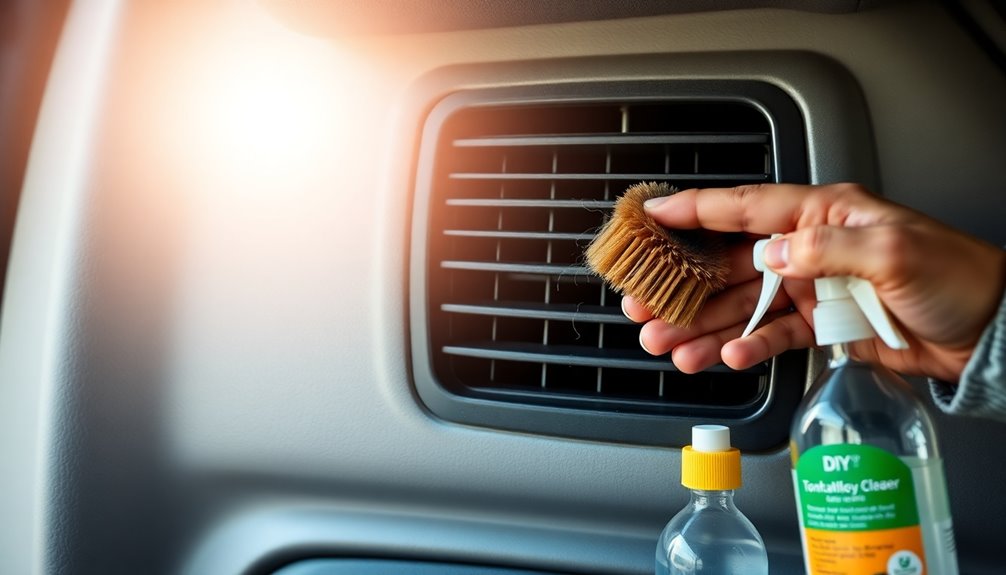
Enhancing air circulation in your vehicle's rear seating area can make a significant difference in passenger comfort. One effective way to achieve this is by installing 12V mini fans, which can provide targeted airflow directly to your rear seats. This additional movement of air guarantees that everyone stays cool, especially on hot days.
You can also optimize your existing HVAC system by closing unused front vents. This simple adjustment redirects more cool air to the rear, making it easier for passengers to enjoy a comfortable ride.
Regular maintenance is key, too; make sure to clean the rear air ducts and check for any obstructions that might hinder airflow.
Additionally, consider utilizing window tinting with high-grade heat rejection material. This not only reduces heat absorption inside your vehicle but also enhances the overall effectiveness of your air circulation efforts.
Pre-cooling your vehicle by running the AC before passengers enter can further lower the interior temperature, creating a pleasant atmosphere.
Vehicle Preparation Techniques
Preparing your vehicle for hot weather can greatly improve comfort for everyone on board. By taking a few simple steps, you can make your ride much more bearable when the temperatures rise. Here are three essential techniques to contemplate:
- Tint Your Windows: Use high-grade heat rejection materials to reduce heat buildup inside your cabin.
- Park Smart: Always look for shaded areas or use sunshades to minimize direct sunlight exposure, keeping the interior cooler while you're parked.
- Maintain Your AC: Regularly check refrigerant levels and clean the coils to guarantee your air conditioner operates at peak performance.
Additionally, keep your cabin air filters clean and replace them as needed. This enhances airflow and maintains a comfortable temperature throughout your travels.
You might also want to reflect on vehicle modifications, such as adding insulation or reflective materials, to improve overall heat management.
User Experiences and Feedback

Experiencing discomfort in hot weather can be frustrating, especially when rear AC vents don't deliver the cooling you expect. Many users report mixed experiences regarding rear AC vent effectiveness, particularly in extreme temperatures exceeding 100 degrees Fahrenheit.
Some find the airflow weak, diminishing notably the further back you go in the vehicle. This can lead to discomfort for rear passengers, especially children, as they often feel airflow only within a few inches of the vents.
Regular maintenance and cleaning of these rear vents are essential to prevent blockages from debris, which can severely hinder airflow and cooling efficiency. Users emphasize that neglecting this can exacerbate issues, resulting in even poorer performance.
Despite these maintenance efforts, some community members suggest considering aftermarket solutions, like additional fans or rooftop AC units, to enhance cooling when factory systems fall short.
Additionally, many users express frustration with dealership responses to complaints about rear AC performance, urging better acknowledgment of design issues affecting airflow and cooling capabilities.
Cost-Effective Solutions
Finding cost-effective solutions for improving rear AC vent performance can make a significant difference in your comfort during hot weather. Here are three practical tips to take into account:
- Regularly Clean Rear AC Vents: Dust and debris can block airflow, so keep your rear return vent and ducts clean to enhance cooling efficiency without breaking the bank.
- Use Affordable 12V Mini Fans: These fans can provide targeted cooling in the rear seating area, boosting airflow without needing pricey modifications or additional AC units.
- Ensure Proper Air Filter Placement: Incorrectly installed air filters can hinder efficiency, leading to costly repairs. Make sure they're installed correctly for peak performance.
Additionally, don't overlook DIY maintenance techniques. Inspect and clean your rear return vent regularly to eliminate obstructions, allowing for better air circulation.
Finally, participate in online forums where you can share and gather cost-effective tips from fellow van owners. Together, you can foster a community of shared knowledge that enhances your rear AC performance while keeping expenses low.
Community Support and Resources
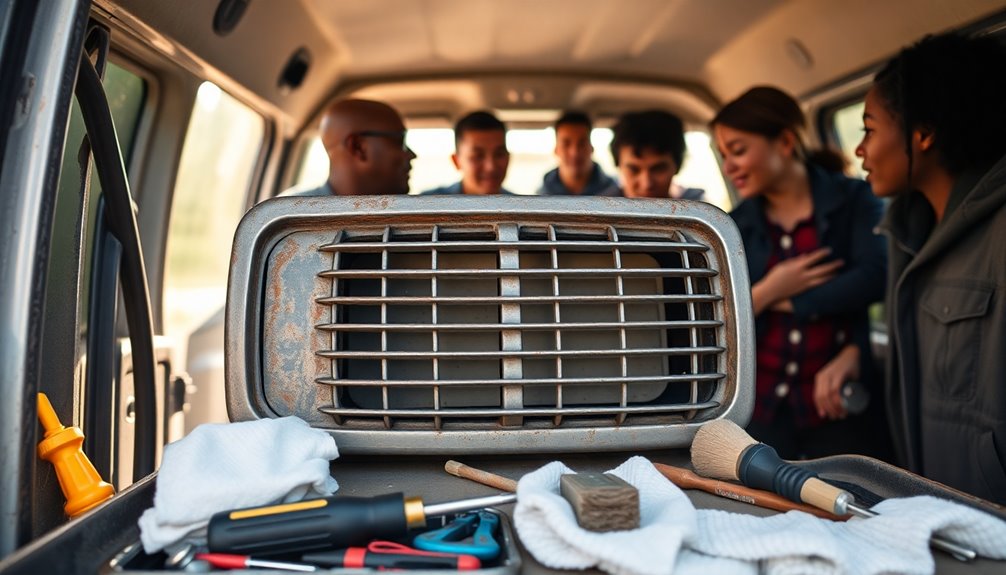
Joining online forums and community groups can be a game-changer for you as a van owner looking to maintain your rear AC vents.
You'll find DIY tips, tricks, and product recommendations shared by others who've faced similar challenges.
Engaging with these communities not only enhances your knowledge but also connects you with valuable resources that can streamline your maintenance efforts.
Online Forums and Groups
Online forums and groups serve as invaluable resources for van owners dealing with rear AC vent maintenance. By joining these online communities, you can tap into a wealth of shared experiences and advice that can save you time and money.
Here are three key benefits of participating in these online forums:
- Targeted Advice: Many forums have sections dedicated to specific van models, allowing you to find tailored solutions for your rear AC system issues.
- DIY Techniques: Community members often share their DIY repair methods and maintenance strategies, helping you tackle problems without professional help.
- Product Reviews: Users frequently post reviews of aftermarket products designed to boost airflow and cooling efficiency, so you can make informed choices when upgrading your system.
Engaging with these online forums not only provides you with practical tips but also fosters a sense of camaraderie among van owners.
You'll gain insights into common problems, innovative fixes, and even updates on potential recalls or manufacturer responses to design flaws, ensuring your ride remains comfortable and efficient.
Don't underestimate the power of community support; it could be your best resource for rear AC vent maintenance.
DIY Tips and Tricks
When it comes to maintaining your van's rear AC vents, tapping into community support can make all the difference. Engaging with online forums dedicated to your vehicle model allows you to share installation experiences and access troubleshooting advice from others who've faced similar rear AC vent issues.
These platforms often feature DIY guides and videos that help you clean and maintain your rear AC vents, ensuring ideal airflow and performance.
Consider participating in local meetups or virtual discussions where you can exchange tips on effective aftermarket solutions or modifications to enhance your rear AC functionality. Utilizing social media groups focused on RV and van travel can also help you crowdsource ideas for cost-effective maintenance practices and innovative cooling solutions.
Don't forget to contribute your own project updates and successes regarding rear AC vent maintenance. Sharing your experiences not only helps others but also enriches the collective knowledge and support within the community.
Product Recommendations and Links
Finding the right products to maintain and enhance your van's rear AC system can greatly improve your comfort on the road.
With so many options available, here are some solid product recommendations to contemplate:
- 12V Mini Fans: These portable fans are budget-friendly and effective for boosting airflow in the rear seating area, providing extra comfort without the need for a generator.
- Specialized Cleaning Kits: Look for kits specifically designed for cleaning vents and ductwork. Regular maintenance can appreciably improve airflow and system efficiency, ensuring your AC runs smoothly.
- Aftermarket Rear AC Units: Community-driven resources often link to reliable rear AC units available for under $750. Upgrading your system can make long drives much more enjoyable.
To get the most out of these product recommendations, engage with online forums like RV forums or van life communities.
Social media groups dedicated to van conversions are invaluable for shared experiences and insights.
Professional Maintenance Considerations
To keep your rear AC system running smoothly, regular professional maintenance is crucial. It guarantees peak airflow and cooling performance, especially in high-temperature environments.
A qualified technician should inspect and clean your rear return vents to prevent blockages caused by debris. These blockages can greatly impair airflow and lead to uncomfortable rides.
Don't forget to have the blower fan checked for efficiency. A failing blower motor can result in inadequate cooling in the rear of your vehicle, leaving passengers uncomfortable.
Additionally, professional maintenance will include checking the refrigerant levels. Improper management of refrigerant can affect cooling efficiency and may lead to costly repairs if neglected.
Consider engaging a professional for a deep cleaning of the ductwork once or twice a year. This service can enhance your van's indoor air quality and improve overall system performance.
Regular maintenance not only keeps your rear AC system functioning effectively but also extends its lifespan, saving you money in the long run.
Conclusion
In the grand scheme of comfort, who would've thought those rear AC vents could be the unsung heroes of your ride? By investing just a bit of time and effort, you'll keep your passengers cool and happy, proving that sometimes the simplest solutions are the most effective. After all, it's not just about you anymore—your backseat buddies deserve a chill ride too. So go ahead, give those vents the love they didn't know they needed!



